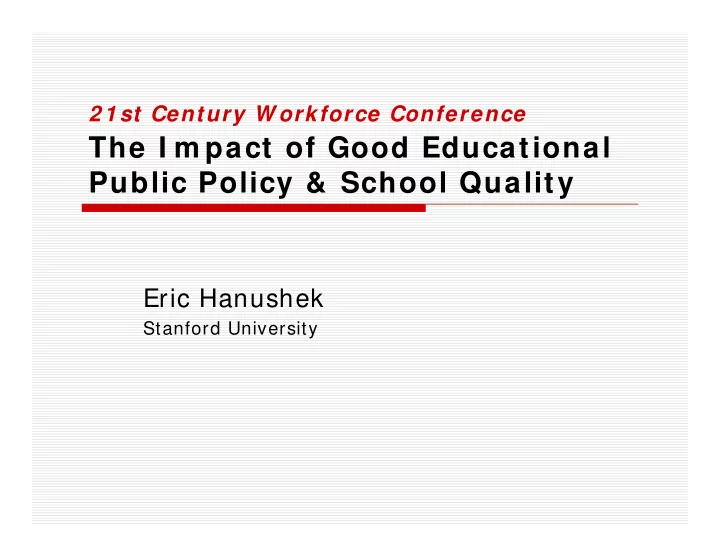

2 1 st Century W orkforce Conference The I m pact of Good Educational Public Policy & School Quality Eric Hanushek Stanford University
Plan of discussion � Consider benefits and costs of investment in quality � Benefits easier to estimate � Bound the costs of quality � Identify possible reforms � Class size reduction, salaries, spending � Teacher quality changes
Summary of results � Benefits of quality improvement large � Individual earnings and productivity � Aggregate effects through growth � Dimensions of reform � Magnitude of quality improvement � Speed of reform � Input approaches generally ineffective � Quality improvements require substantial changes in teacher quality
Earnings and productivity � Consistent impact of quality (test performance) � Earnings � School attainment � U.S. results: ½ standard deviation perform ance → 6 percent higher annual earnings
Aggregate growth � Quality very important � Marginal effect � Other things: property rights, open product and labor markets, limited governmental intrusion ½ standard deviation national → ½ percent increase annual grow th
Summary: Benefits from School Quality very large � Individuals and society gain significantly � Can finance reform I F reform is effective
Dimensions of Reform � Magnitude � Must focus on objectives � Most discussions entirely on inputs � Speed � Cannot change schools instantly � Must have long view
Improved GDP with Moderately Strong Knowledge Improvement 8% DP percent additions to G 6% 4% 2% 0% 2005 2010 2015 2020 2025 2030 2035 2040 year 10-year reform 20-year reform 30-year reform
Ineffectiveness of Resource Policies � Common approach – increase resources � Reduce class size � Increase salaries � Increase certification requirements for teachers � Substantial evidence that these do not work
U.S. NAEP perform ance (17 year olds) 320 310 300 1970 290 1980 280 1990 270 1999 260 250 math reading science writing
Public school resources, 1 9 6 0 - 2 0 0 0 1960 1980 2000 25.8 18.7 17.3 Pupil-teacher ratio 24 50 56 % master’s degree 11 12 15 Median experience $2,235 $5,124 $7,591 Spending/pupil
Washington Performance 8 th Grade NAEP, 2003 US WA Reading 261 264 Math 276 281
Washington Performance 8 th Grade NAEP, 2003 white students US WA US WA Reading 261 264 270 268 Math 276 281 287 285
Basic or Above Perform ance 8 th Grade NAEP, 2003 US WA Reading 72 76 Math 67 72
Basic or Above Perform ance 8 th Grade NAEP, 2003 white students US WA US WA Reading 72 76 82 80 Math 67 72 79 76
Resource evidence � Econometric analyses � Experimental evidence (Project STAR)
Importance of teachers � Total effects versus measured characteristics � Consistent differences in teachers � Magnitude (lower bound): 1 s.d. ( teacher) → 0 .1 2 s.d. ( student) � Other evidence: good → bad = 1 grade level equivalent
Annual Required Hiring Percentile for Moderately Strong Improvement in Student Achievement 65% 61.3% 60% 55.7% 55.5% 55% 53.8% 52.7% 51.8% 50% 10-year 20-year 30-year Speed of reform low teacher replacement high teacher replacement
Uncertainty about exact incentives � Pure resource policy ineffective � Rigidities in hiring/ retention � Little direct analysis of incentives � Alternatives � Accountability � Choice
Improved GDP with Moderately Strong Knowledge Improvement 8.0% percent additions to GDP 6.0% 4.0% 2.0% 0.0% 2005 2010 2015 2020 2025 2030 2035 2040 year 10-year reform 20-year reform 30-year reform typical education spending
Recommend
More recommend